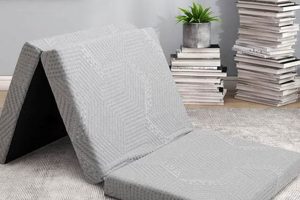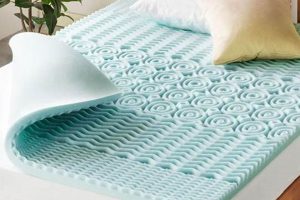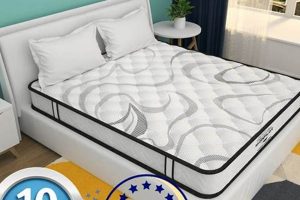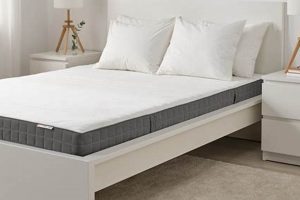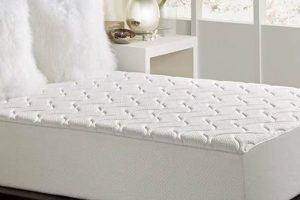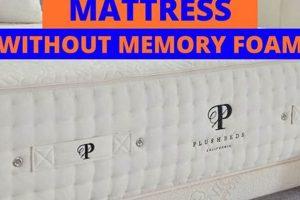This sleep surface enhancement is designed to conform to the body’s unique contours, providing customized support and pressure relief. The numerical component indicates its thickness, measured in inches, a factor directly influencing the degree of cushioning and overall comfort. A common application involves placing it atop an existing innerspring or hybrid mattress to improve its feel and extend its lifespan.
Utilizing this particular product offers several advantages, including enhanced spinal alignment, reduced motion transfer, and improved sleep quality. Historically, such additions have evolved from simple padding to sophisticated materials engineered for optimal temperature regulation and durability. The increased density compared to thinner options contributes to longevity and sustained performance.
The following sections will delve into the material composition, ideal candidates, selection criteria, and maintenance considerations when considering a mattress overlay of this specific thickness, offering a comprehensive guide for informed decision-making.
Enhancing Sleep with a Three-Inch Memory Foam Layer
The following tips address key aspects of selecting, using, and maintaining a 3-inch memory foam mattress overlay to optimize sleep quality and product longevity.
Tip 1: Prioritize Density: A higher density foam, typically measured in pounds per cubic foot (PCF), indicates greater durability and resistance to compression. Opt for a density of at least 3 PCF for improved support and long-term performance.
Tip 2: Evaluate Ventilation: Memory foam can trap heat. Look for models incorporating open-cell structures or gel infusions to promote airflow and regulate temperature, preventing overheating during sleep.
Tip 3: Consider Body Weight and Sleeping Position: Individuals with higher body weights may benefit from firmer options to ensure adequate support and prevent excessive sinking. Side sleepers often prefer softer foams to alleviate pressure on shoulders and hips, while back sleepers generally benefit from medium-firm densities.
Tip 4: Assess Existing Mattress Condition: The overlay can improve comfort, but it cannot compensate for a severely damaged or worn-out underlying mattress. Ensure the existing mattress provides a stable and relatively even surface for optimal results.
Tip 5: Implement Proper Support: A suitable foundation or bed frame is essential to prevent sagging and maintain the integrity of both the overlay and the mattress beneath. Consider a platform bed or a slatted frame with closely spaced slats.
Tip 6: Maintain Cleanliness: Regularly clean the overlay according to the manufacturer’s instructions. Use a mattress protector to shield it from spills, stains, and dust mites, extending its lifespan and promoting a hygienic sleep environment.
Tip 7: Allow for Initial Expansion: Upon unboxing, allow the overlay to fully expand for 24-72 hours in a well-ventilated room. This ensures it reaches its intended shape and firmness before use.
Adhering to these guidelines will help ensure optimal comfort, support, and longevity from the product, leading to improved sleep and overall well-being.
The subsequent discussion will focus on troubleshooting common issues and exploring alternative sleep surface solutions.
1. Density and Support
Density, measured in pounds per cubic foot (PCF), directly influences the support characteristics of a 3-inch memory foam mattress overlay. Higher density foam provides greater resistance to compression, resulting in enhanced support and reduced sinkage. This is particularly crucial for individuals requiring substantial spinal alignment and pressure relief. For instance, a person with a higher body weight will benefit from a higher density overlay to prevent bottoming out and maintain proper support, while a lighter individual might find sufficient support in a medium-density option. Without adequate density, a 3-inch overlay may fail to deliver its intended comfort and therapeutic benefits.
The relationship between density and support also affects the longevity of the product. A lower density overlay will degrade more rapidly under continuous pressure, losing its supportive properties and requiring replacement sooner. Conversely, a higher density foam maintains its structural integrity over time, offering consistent support and extending the overlay’s lifespan. This has direct implications for the overall cost-effectiveness of the product, as a more durable, higher density option may prove more economical in the long run despite a higher initial price.
In conclusion, the density of a 3-inch memory foam mattress overlay is a primary determinant of its support capabilities and durability. Selecting an appropriate density based on individual needs and body weight is essential for achieving optimal comfort, spinal alignment, and long-term value. Overlooking this critical factor can lead to dissatisfaction and diminished therapeutic benefits, ultimately undermining the purpose of the product.
2. Heat Dissipation
The ability of a 3-inch memory foam mattress overlay to dissipate heat significantly impacts sleep quality and comfort. Memory foam’s inherent structure can restrict airflow, leading to heat retention, a common concern for users. Effective heat dissipation strategies are therefore crucial in mitigating this issue.
- Open-Cell Structure
Open-cell foam features interconnected cells that promote air circulation within the material. This allows heat to escape more readily compared to traditional closed-cell memory foam. The increased airflow reduces heat buildup, contributing to a cooler sleep surface. In the context of a 3-inch overlay, the effectiveness of the open-cell structure is amplified due to the greater volume of material.
- Gel Infusions
Gel-infused memory foam incorporates gel particles designed to absorb and dissipate heat. These particles can be strategically distributed throughout the foam to enhance thermal conductivity. Some gel infusions are phase-change materials that actively draw heat away from the body. The integration of gel technology within a 3-inch overlay provides a supplementary mechanism for temperature regulation.
- Convoluted Surface Designs
Convoluted, or egg-crate, surface designs create air channels that enhance ventilation between the body and the overlay. The peaks and valleys of the surface allow for greater airflow, reducing heat buildup and promoting evaporation of moisture. These designs are particularly beneficial for those prone to night sweats or who sleep in warmer climates. The added surface area of a convoluted 3-inch overlay maximizes its cooling potential.
- Breathable Covers
The cover of the overlay plays a vital role in heat dissipation. Breathable fabrics, such as cotton, bamboo, or specialized performance knits, allow air to circulate freely. These materials wick away moisture, further contributing to a cooler and more comfortable sleep environment. A breathable cover complements other heat dissipation technologies within the 3-inch memory foam overlay.
The integration of these heat dissipation strategies is crucial for optimizing the comfort and functionality of a 3-inch memory foam mattress overlay. Failing to address heat retention can negate the pressure-relieving benefits of the foam, leading to discomfort and disrupted sleep. Therefore, careful consideration of heat dissipation features is essential when selecting such an overlay.
3. Thickness Benefits
The 3-inch dimension of a memory foam mattress overlay directly influences its performance characteristics, offering a balance between comfort, support, and pressure relief. A thinner overlay, such as one inch, may provide minimal cushioning, while a thicker option, such as four inches or more, might result in excessive sinkage, especially for individuals with lower body weights. The 3-inch thickness, therefore, presents a compromise designed to accommodate a wide range of body types and sleeping preferences. A practical example is the improved spinal alignment often experienced by side sleepers when using a 3-inch overlay, as it allows the shoulders and hips to sink in sufficiently to maintain a neutral spine position.
Furthermore, the thickness contributes significantly to the reduction of motion transfer. The 3-inch memory foam layer absorbs and isolates movement, minimizing disturbances for partners sharing a bed. This is particularly beneficial when one partner is restless or has a different sleep schedule. Consider a scenario where one individual frequently gets up during the night; a 3-inch memory foam mattress overlay would mitigate the transmission of movement across the mattress, allowing the other partner to sleep undisturbed. The effectiveness of this motion isolation increases with the thickness of the foam, but beyond a certain point, the increase in thickness yields diminishing returns relative to potential drawbacks like increased heat retention.
In summary, the 3-inch thickness of a memory foam mattress overlay is a critical factor determining its ability to provide adequate comfort, support, and motion isolation. The specific dimension represents a deliberate design choice aimed at optimizing these benefits for a diverse range of users. While individual preferences may vary, the 3-inch thickness generally provides a well-rounded sleep experience, offering a tangible improvement in comfort and support without sacrificing stability or exacerbating issues such as heat retention.
4. Mattress Protection
A 3-inch memory foam mattress overlay inherently serves as a protective barrier for the underlying mattress. This protection stems from the overlay’s capacity to absorb daily wear and tear, shielding the mattress from spills, stains, and the accumulation of dead skin cells and dust mites. For instance, without a 3-inch memory foam mattress overlay, a beverage spill could directly permeate the mattress, leading to potential mold growth or permanent staining. The overlay, acting as a sacrificial layer, absorbs the liquid, preventing it from reaching the underlying mattress core.
Beyond preventing surface damage, the overlay also distributes weight more evenly, mitigating concentrated pressure points that can lead to mattress sagging over time. Consider a scenario where an individual consistently sleeps in the same position on the mattress. Without a 3-inch memory foam mattress overlay, the weight would be concentrated on a specific area, potentially causing the mattress coils or foam to compress prematurely. The overlay, by conforming to the body’s contours, spreads the weight across a larger surface area, reducing the likelihood of localized sagging and extending the mattress’s usable lifespan. This, in turn, reduces the frequency of mattress replacements, representing a significant cost savings over time.
The protective function of a 3-inch memory foam mattress overlay is a critical consideration for individuals seeking to prolong the life and maintain the hygiene of their existing mattress. While not a substitute for a dedicated mattress protector, the overlay provides an additional layer of defense against common sources of mattress degradation. Implementing this protective measure can contribute to a cleaner, more durable, and ultimately more cost-effective sleep environment. Failure to consider this protective benefit when evaluating a 3-inch memory foam mattress overlay would be to overlook a significant aspect of its overall value and functionality.
5. Longevity and Care
The durability and sustained performance of a 3-inch memory foam mattress overlay are inextricably linked to the implementation of proper care protocols. Neglecting these practices can prematurely degrade the material, diminishing its supportive qualities and shortening its lifespan, thereby negating the initial investment.
- Regular Cleaning Practices
Consistent cleaning is paramount to remove accumulated dust, allergens, and bodily fluids. Vacuuming the surface with a brush attachment every one to two months mitigates the buildup of particulate matter that can compromise the foam’s structural integrity over time. Spot cleaning spills immediately with a mild detergent prevents staining and the growth of mold or mildew within the foam matrix. Inadequate cleaning fosters a breeding ground for allergens and accelerates material degradation.
- The Use of Mattress Protectors
A waterproof and breathable mattress protector serves as a critical barrier against liquid spills and stains. This preventative measure safeguards the memory foam from direct exposure to moisture, which can foster microbial growth and degrade the foam’s composition. The protector also shields against the accumulation of dead skin cells and dust mites, reducing the risk of allergic reactions and maintaining a more hygienic sleep environment. A protector is imperative to extend the life of the 3-inch overlay.
- Proper Support Systems
The foundation upon which the mattress and overlay rest significantly impacts longevity. A sagging or uneven bed frame can create concentrated pressure points on the overlay, leading to localized compression and premature wear. Employing a robust and level support system, such as a platform bed or a slatted frame with closely spaced slats, ensures uniform weight distribution, minimizing stress on the foam and extending its lifespan. An inadequate base compromises the overlay’s structural integrity.
- Rotation and Flipping (If Applicable)
While not all 3-inch memory foam mattress overlays are designed to be flipped, regular rotation can help distribute wear more evenly across the surface. Rotating the overlay 180 degrees every three to six months prevents the formation of body impressions and prolongs its supportive capabilities. If the manufacturer recommends flipping the o
verlay (which is less common), following this guidance further distributes wear. Consistent rotation maximizes the overlay’s effective lifespan.
Adherence to these care guidelines is essential for preserving the integrity and extending the lifespan of a 3-inch memory foam mattress overlay. Neglecting these practices will inevitably lead to premature degradation, diminished performance, and the need for earlier replacement, undermining the initial investment and compromising the quality of sleep. These actions are not optional, but fundamental to ensuring the long-term value and performance of the product.
Frequently Asked Questions
The following addresses common inquiries regarding 3-inch memory foam mattress overlays, providing clarity on their usage, maintenance, and suitability.
Question 1: How does the density of a 3-inch memory foam mattress topper affect its performance?
Density, measured in pounds per cubic foot (PCF), dictates the topper’s support and durability. Higher density translates to greater resistance to compression, ensuring consistent support and a longer lifespan. Lower density options are prone to premature sagging and reduced support.
Question 2: Can a 3-inch memory foam mattress topper alleviate back pain?
A 3-inch topper may assist in relieving back pain by contouring to the body and promoting spinal alignment. However, its effectiveness depends on individual circumstances and the underlying mattress condition. It is not a substitute for medical advice or treatment.
Question 3: What are the primary considerations for preventing overheating with a 3-inch memory foam mattress topper?
Heat retention is a potential issue. Opt for toppers incorporating open-cell foam, gel infusions, or convoluted surfaces to enhance airflow and dissipate heat. A breathable cover also contributes to temperature regulation.
Question 4: How often should a 3-inch memory foam mattress topper be cleaned?
Vacuuming the surface every one to two months is recommended to remove dust and allergens. Spot clean spills immediately with a mild detergent. Adherence to the manufacturer’s care instructions is crucial.
Question 5: What is the expected lifespan of a 3-inch memory foam mattress topper?
The lifespan varies depending on density, usage, and care. Higher density toppers, properly maintained, can last five years or more. Lower density options may require replacement sooner.
Question 6: Can a 3-inch memory foam mattress topper improve the comfort of an old mattress?
A 3-inch topper can enhance the comfort of an older mattress by providing additional cushioning and pressure relief. However, it cannot compensate for a severely damaged or worn-out mattress. A stable and relatively even underlying surface is necessary for optimal results.
In summary, the performance and longevity of a 3-inch memory foam mattress topper depend on factors such as density, care practices, and the condition of the underlying mattress. Careful consideration of these aspects will ensure optimal benefits and a more comfortable sleep experience.
The next section will explore potential alternatives to 3-inch memory foam mattress toppers.
In Conclusion
This exposition has detailed the significant characteristics of the 3 memory foam mattress topper, focusing on its material properties, beneficial applications, and essential maintenance. Density, ventilation, and appropriate support are critical considerations in optimizing its performance. The balance between pressure relief and motion isolation conferred by this specific thickness contributes to its widespread adoption.
Ultimately, the informed selection and responsible care of a 3 memory foam mattress topper determine its efficacy in enhancing sleep quality and extending mattress lifespan. Continued research into advanced materials and design innovations promises further refinements in comfort and durability, underscoring its enduring relevance in the pursuit of restful sleep.


